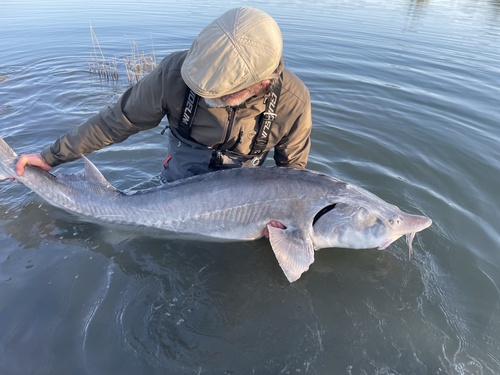
Beluga Sturgeon
The Bluefin Tuna (Thunnus) is among the largest and fastest fish in the ocean. These apex predators are renowned for their incredible migrations and commercial value. Three main species exist: Atlantic, Pacific, and Southern. They are a vital part of the marine ecosystem.
10 118 years
Lifespan
150 - 800 cm
Length
Critically Endangered
Conservation Status
20 km/h
Swimming speed
Carnivorous, Scavengers
Diet
Diadromous Migration - Anadromous
Migration
Appearance Overview
The Bluefin Tuna is renowned for its large, streamlined body, built for speed and endurance in the water.
Color
Dark metallic blue on top with a silvery underside
Fins
Two dorsal fins, the first depressible; small finlets run from dorsal and anal fins to tail
Body
Torpedo-shaped, designed for efficient swimming
Length
Up to 10 feet (3 meters), though some can reach 14 feet
Weight
Typically up to 550 lbs (250 kg), but can reach over 1,500 lbs (680 kg)
Diet
Carnivorous, feeding on fish, squid, crustaceans, and occasionally on plankton and other small organisms.
Feeding Behavior
Uses speed and agility to chase down prey, often hunting in coordinated schools. They are opportunistic feeders.
Social Behavior
Highly migratory and forms large schools, particularly during spawning. They can be solitary at times, especially when foraging.
Commercial Relevance
Extremely high value in the global seafood market, especially in Japan for sushi and sashimi. Its rich, fatty flesh is a delicacy.
Conservation measures
Subject to international fishing quotas and regulations, marine protected areas, and efforts to improve fishing gear selectivity.
Status
Varies by species; Atlantic Bluefin is Endangered, Pacific Bluefin is Vulnerable, and Southern Bluefin is Critically Endangered.
Threats
Overfishing is the primary threat, exacerbated by illegal fishing. Climate change and habitat degradation also impact populations.
Habitat Distribution
Depth Range
Typically found in surface waters to depths of 50-500 meters, but can dive to over 900 meters.
Geographic Range
Atlantic Bluefin: Western and Eastern Atlantic, Mediterranean Sea. Pacific Bluefin: North Pacific Ocean. Southern Bluefin: Southern Hemisphere oceans.
Preferred Environment
Prefers temperate and subtropical waters; highly migratory, often following warm ocean currents.
Reproduction and Life Cycle
Breeding Habits
Spawns in warm waters, with key spawning grounds including the Gulf of Mexico and the Mediterranean Sea. Spawning season varies by species and region.
Development Stages
Larvae hatch in plankton-rich waters and grow rapidly. Juveniles form schools and continue to develop, reaching adult size over several years.
Fecundity
Females can produce millions of eggs per spawning season, releasing them into the water for external fertilization.
Maturity Age
Varies by species; Atlantic Bluefin typically matures at 4-8 years, Pacific at 3-5 years, and Southern at 8-12 years.
Faqs about Beluga Sturgeon
How far can Bluefin Tuna migrate?
Bluefin Tuna are highly migratory, traveling vast distances across oceans. They are capable of crossing the Atlantic in under 60 days.
Where can Bluefin Tuna be found?
Bluefin Tuna are found in the Atlantic, Pacific, and Indian Oceans, including the Mediterranean Sea.
How do Bluefin Tuna maintain their body temperature?
Bluefin Tuna have a specialized circulatory system that allows them to maintain a body temperature higher than the surrounding water, aiding in their speed and endurance.
How fast can Bluefin Tuna swim?
Bluefin Tuna can swim at speeds up to 43 mph (70 km/h) when chasing prey or avoiding predators.
Are Bluefin Tuna warm-blooded?
Yes, Bluefin Tuna are warm-blooded, which is unusual among fish. This helps them survive in colder waters and maintain high activity levels.
How long do Bluefin Tuna live?
The lifespan of Bluefin Tuna can vary, but they generally live up to 15-30 years, with some individuals living even longer.
What do Bluefin Tuna eat?
Bluefin Tuna primarily feed on fish, squid, and crustaceans. They are opportunistic predators and will also consume other small marine organisms.
What is the biggest threat to Bluefin Tuna?
Overfishing is the biggest threat to Bluefin Tuna populations, driven by high demand in the seafood market.
Why is Bluefin Tuna meat so prized?
Bluefin Tuna meat is highly prized in sushi and sashimi due to its rich flavor, tender texture, and high fat content.
What conservation efforts are in place to protect Bluefin Tuna?
Efforts include international fishing quotas, monitoring of populations, and the establishment of marine protected areas to safeguard their habitats.
Copyright @ Nature Style Limited. All Rights Reserved.
 English
English